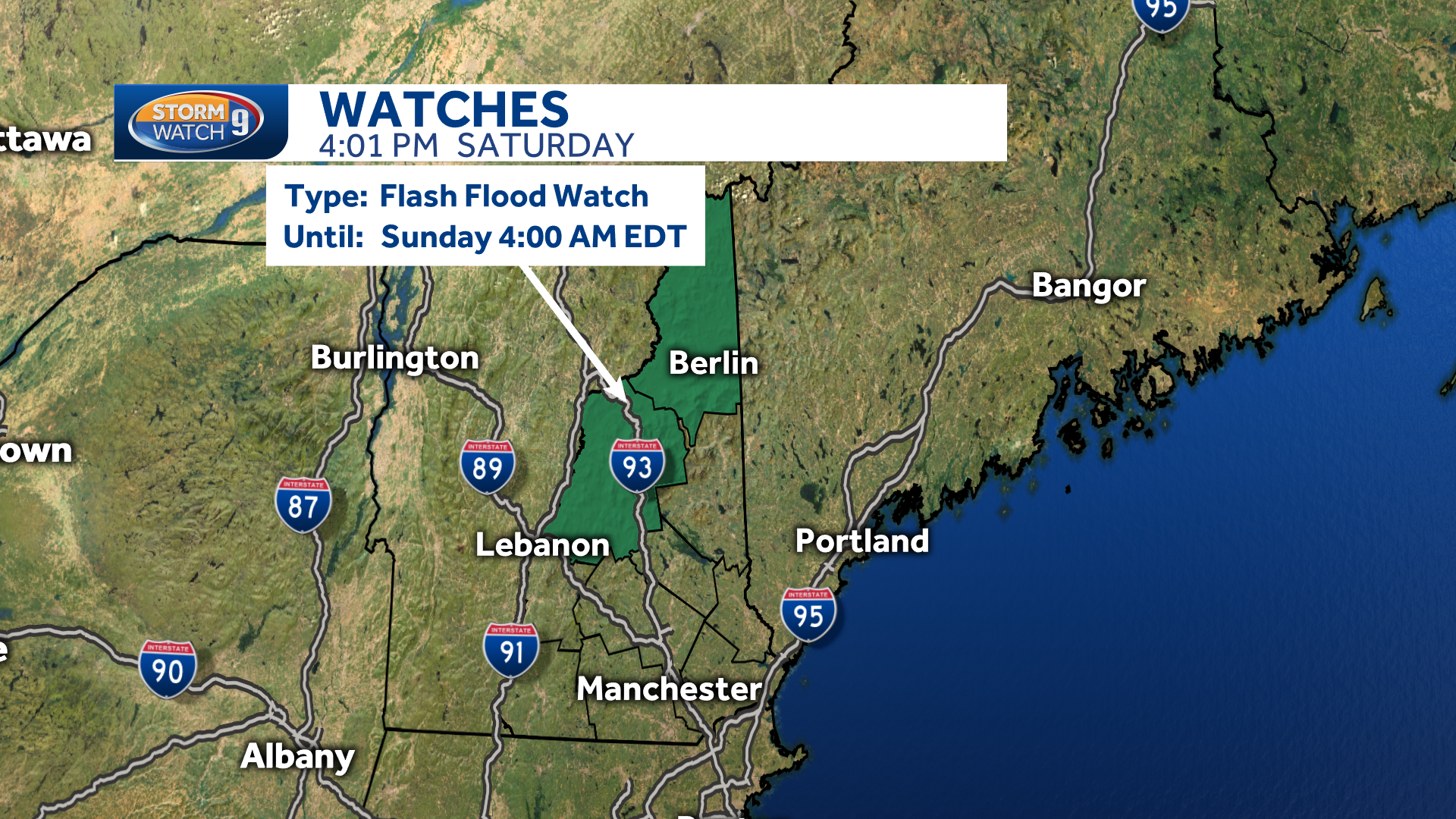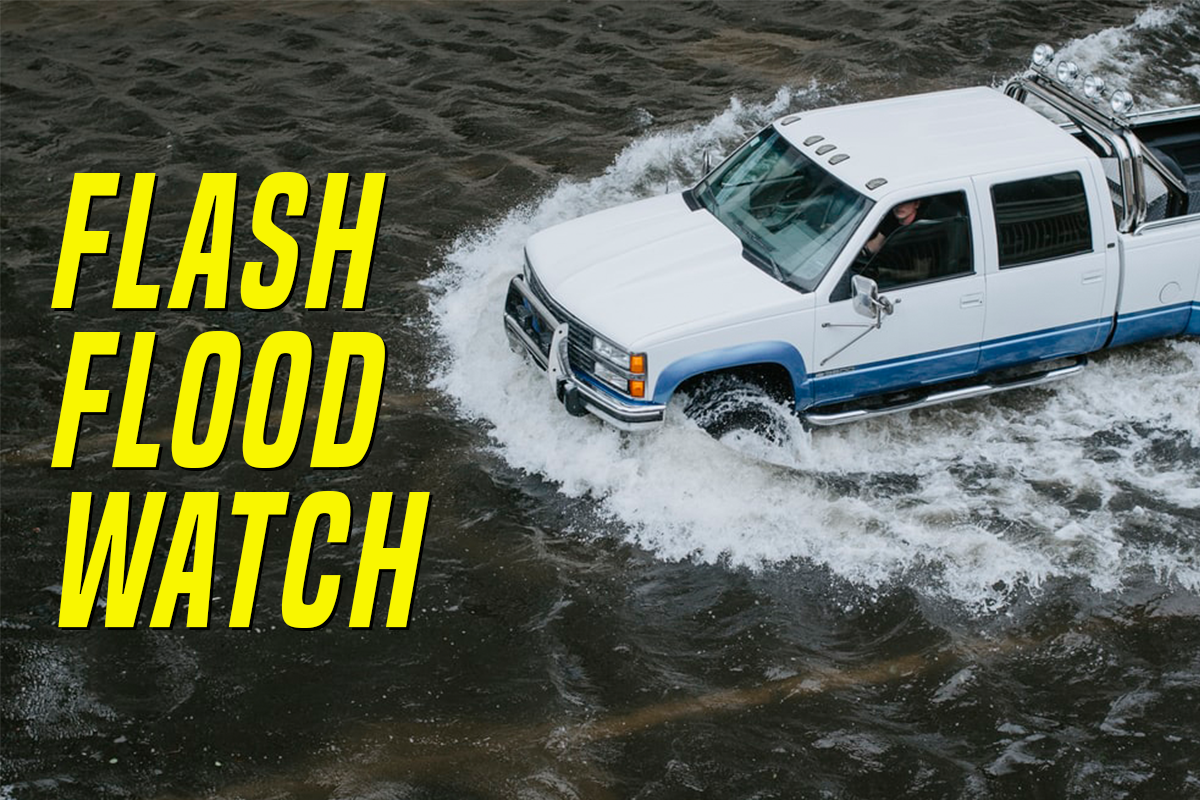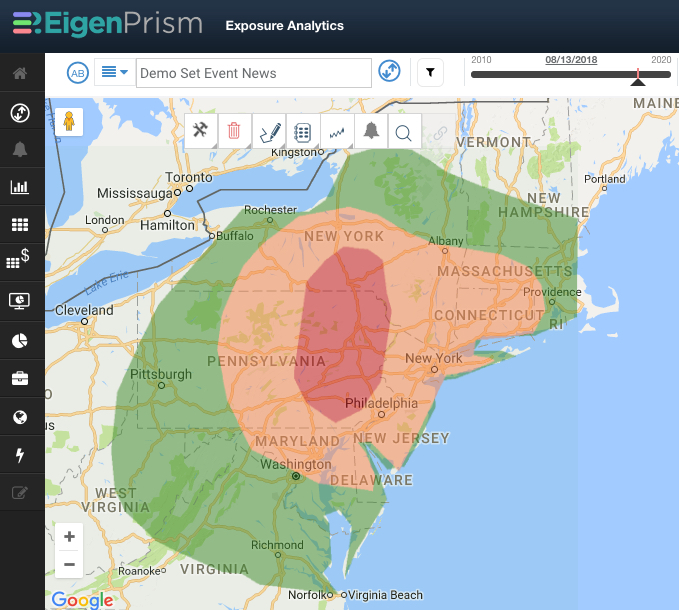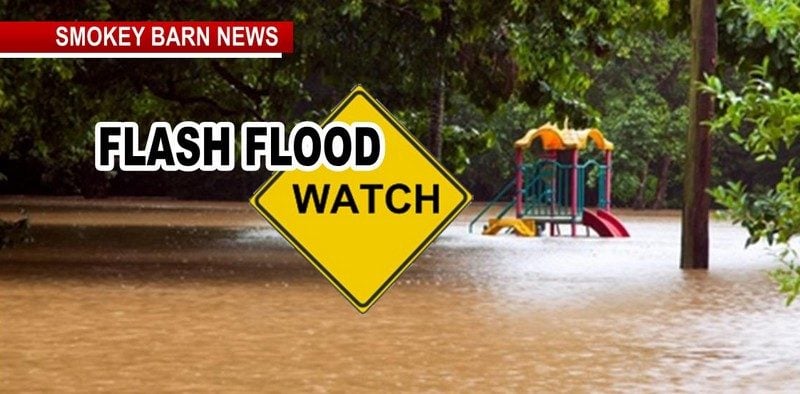NEW YORK — A slow-moving cold front brought the potential for flooding with serious downpours Thursday night. The rain should diminish in intensity during the overnight hours; however the showers will linger into Friday morning. Numerous flash flood warnings were issued across Northern New Jersey as rainfall rates in excess of 2 inches per hour caused flooding on area roadways and winds have been gusty causing a few scattered power outages as well. A flash flood watch has been issued for seven New Jersey counties starting Thursday afternoon with heavy rain and the threat of severe thunderstorms that could drop more than 2 inches of rainfall on parts of the state. Much of the region could see 2 to 5 inches of rain from the system, according to the weather service, with some areas likely seeing more than 6 inches by the time it moves out Thursday.
A flash flood watch is in effect from Wednesday morning through Thursday evening. The rain on Wednesday night — 3.1 inches in Central Park within an hour — shattered the record set only last week, when 1.94 inches of rain fell in the park during Tropical Storm Henri. The National Weather Service issued a flash flood emergency in New York City for the first time. The National Weather Service has issued a flash flood watch in northern New Jersey and parts of central New Jersey through Friday morning, with heavy rainfall expected to hit the state along with the chance of severe thunderstorms.
A flash flood watch is also in effect across the region through Thursday morning, as Ida is expected to dump 3 to 6 inches of rain. Flash flood warnings have been issued in parts of the Poconos to the north. The National Weather Service has issued a flash flood watch for seven New Jersey counties through 8 a.m.
Friday with heavy rainfall expected to hit the state along with the chance of severe thunderstorms. The region is once again under a flash flood watch, with scattered thunderstorms and as much as 1 inch of rain per hour expected to fall between Thursday afternoon and Friday morning. The National Weather Service issued a flash flood watch for New York City until Thursday at 2 p.m. City emergency management officials warned that 5 to 6 inches of rain were expected with locally higher amounts of up to 8 inches possible. More than 50 million people in the Northeast alone remained under a flash flood watch or warning, four days after Ida roared ashore in Louisiana as a Category 4 hurricane.
The winds had vastly diminished, but the storm was dishing out heavy rain, much of it in areas already saturated by recent deluges. After Elsa brought torrential rains to the Northeast last week leaving the ground saturated there is the potential that new heavy rain will cause considerable flash flooding. This could occur especially in locations with poor drainage and in urban areas. Rainfall rates could exceed 1 inch per hour with total rainfall between 1 and 3 inches, but could be higher in certain locations. Scattered showers and isolated thunderstorms will linger through Sunday evening providing the conditions for additional flooding.
The National Weather Service issued its first ever flash flood emergency warning for New York City, as the remnants of Hurricane Ida brought heavy rain that flooded subway lines and streets in Manhattan, Brooklyn and New Jersey. The National Weather Service issued a flash flood watch in Jersey City and other parts of North Jersey for Thursday through Friday morning. The NWS projects 1 to 3 inches of rain across North Jersey, but said local rainfall totals could climb to 5 inches on Thursday and Friday. The most severe thunderstorms are expected between 8 p.m. Thursday, traveling west to east, according to the weather service. Additionally, these thunderstorms will be capable of rainfall rates of at least 1 inch per hour, prompting the concern for localized flash flooding over northwestern New Jersey once again.
"The heavy rainfall may produce flash flooding threats for western New Jersey in the afternoon and evening hours." However, with a forecast of 1 to 2+ inches of rain in play, we have to keep our current status in mind. (Called "antecedent" conditions.) Many communities across New Jersey are still a mess.
Flood warnings continue for the Passaic River through Morris, Passaic, and Essex counties, with water levels still running just above flood stage. And unfortunately, that is the exact corner of the state most likely to see heavy rain from Wednesday evening's storm system. With humid, moisture-rich air moving north and east, the atmosphere will contain a significant amount of precipitable water that could easy rain-out 1-2″ in a short period of time.
Any strong thunderstorms that form could yield high or even higher amounts. With the ground still wet from the past flooding from the remnants of Hurricanes Henri and Ida, any rain, especially heavy rain, could trigger flood conditions. While not everyone will flood, with widespread 1/2″-1″ rainfall expected, the areas that could see 1-2″ of rain could see flood conditions, especially if heavy rain falls over a short period of time. The National Weather Service has issued flash flood warnings and flood advisories in nine areas of New Jersey where heavy rain has been falling Thursday, putting streets at risk of rapid flooding. A slow moving frontal system is bringing very heavy rain from the central U.S. to the East Coast.
Over 3 inches of rain caused flash flooding in the Detroit region on Friday. Over 5 inches of rain was reported in Indiana, nearly 6 inches of rain was reported in Illinois, and over 10 inches of rain was reported in Kansas. Just a few days earlier, the remnants of Tropical Storm Fred dumped up to 5 inches of rain in some areas, leading to flash flooding around the Lehigh Valley that prompted water rescues.
The system also spawned two tornadoes — one in Tilden Township, Berks County, outside of Hamburg, and a second, EF-1, that caused damage from Souderton, Montgomery County, to Perkasie, Bucks County. Thunderstorms with heavy rain are expected to move through the region Wednesday evening. The ground is already saturated due to the heavy rain last week. Additional heavy rainfall of one to two inches is possible in a short period of time, and could quickly lead to flooding in areas that are flood-prone and other low-lying areas. Between 2 to 3 inches of rainfall may potentially fall across parts of New Jersey in the next few days, as multiple counties have already been issued a flash flood watch.
The Storm Prediction Center has put NJ in a "marginal risk" zone for dangerous weather for Thursday and Thursday night. That translates to a 5% of damaging winds and 2% chance of a tornado. I realize those numbers don't mean much — in plain English, the severe threat is worth mentioning, but I'm more worried about the flash flooding potential here. The weather service says 1 to 2 inches of rain has already fallen in the areas that are under a flash flood warning.
A flash flood watch will be in effect for Sussex, Warren, Morris, Hunterdon, Somerset, Middlesex and Mercer counties from Thursday afternoon through Friday morning. Though rainfall totals in those counties are expected to be less than 3 inches, if the cold front stalls locally higher amounts are possible. Strong, potentially damaging wind gusts are the main concern from any severe thunderstorms that move through. Stronger, slow-moving thunderstorms bringing torrential rain also bring the threat of dangerous flash flooding and frequent lightning.
The system is moving east this morning and will bring more heavy rain to parts of the Ohio Valley and ultimately into the Northeast. Severe storms, including the risk for possible tornadoes and damaging winds will be possible from Maryland to New York today, including Philadelphia and New York City. It'll allow for deep tropical moisture along the Middle Atlantic and Northeast areas, producing heavy rain Wednesday morning — with the heaviest rain late Wednesday afternoon and night. The rainfall should begin to taper off Thursday morning in the early afternoon, the NWS said. Some of the hardest-hit areas were in the Philadelphia suburbs.
In Montgomery County, officials said at a news briefing that "the size and scope of the damage from this storm has been vast," with record flooding prompting hundreds of water rescues, and a possible tornado. Three people had died in the county, officials said, two apparently from drowning. Wednesday, a round of spotty showers and thunderstorms is expected over New Jersey. These hit or miss storms may become strong or severe, given our warm and humid atmosphere. Gusty winds, pockets of heavy rain, frequent lightning, and even an isolated tornado are possible. A Flash Flood Watch continues for approximately the northern half of New Jersey too.
The incoming storms have produced 1 to 1.5 inches of rain over eastern Pennsylvania, right on the forecast target. But river levels are only expected to rise a few inches from such rainfall. A "watch" is a formal heads-up that severe weather - including wind, hail, and tornadoes - is possible within the next few hours.
If such conditions do develop, warnings would be issued. The threat for flooding will primarily occur during and just after the heavy rain — it won't last long. There are some river tide gauges that are forecast to touch the minor flooding category, including the Arthur Kill , the Delaware River, and the Maurice River. However, unless rainfall significantly overperforms expectations, we should not see widespread water inundation issues from this storm system.
"Much of this rainfall may occur in a short period of time, leading to the threat of at least localized flash flooding," the weather service said. The Weather Service put southeastern Pennsylvania at an 'elevated' risk for flash flooding and strong storms. Along with saturated grounds making flooding possible, the weather service says creeks, streams, and areas of poor drainage could run over. A cold front will help push a band of strong storms across the region into the overnight hours.
Damaging winds and heavy rain will be the greatest threat to the region associated with the storm system. Forecasters warn that the possibility of an isolated tornado can't be ruled out. Showers likely, then showers and possibly a thunderstorm after 2pm. Some of the storms could produce gusty winds and heavy rain. A flood emergency, as opposed to a warning, is issued in "exceedingly rare situations when a severe threat to human life and catastrophic damage from a flash flood is happening or will happen soon", the NWS said. Up to three inches of rain, flash flooding and damaging winds were expected Thursday across New Jersey.
Southeast wind 6 to 13 mph becoming west after midnight. Many of these areas in the storm's path have already received exceptional rain this summer, leaving some rivers higher and soils more saturated, worsening the risk of flooding. The Middle Tennessee Valley, which experienced flash flooding earlier this month that killed at least 20 people, may see up to four inches of rain on Tuesday and Wednesday. The amount of rainfall associated with a tropical cyclone has to do with how hard it rains and for how long, which itself depends on a cyclone's speed. Rainfall from Hurricane Harvey, the wettest tropical cyclone on record, dropped more than 60 inches in eastern Texas in 2017.
The heavy rain, and subsequent flooding, was caused in part by the hurricane stalling near the coastline. The weather service also said that the storm may bring strong winds and tornadoes, which have the potential to upend trees and power lines. The strong winds are expected to strike north of Interstate 195 and west of Interstate 95, which is in central New Jersey.
—By the way, there could be some downpours in South Jersey, especially as this storm system wraps up on Thursday. But because the southern half of NJ was largely spared from the heavy rain of Ida last week, flash flooding is not expected to be a widespread problem there. Rain has started to push into southwestern New Jersey, right on schedule. And we already have seen a few severe thunderstorm and flash flood warnings posted. I would call them "precautionary" alerts so far — yes, there are some strong thunderstorm cells out there, but I haven't seen any weather that's truly "dangerous" yet.
Flash Flood Warning issued for northwestern Gloucester County and northwestern Salem County until 3 p.m. Doppler radar indicated thunderstorms producing heavy rain across the warned area. In general, the heaviest rain is expected in North Jersey, "though a period of heavy rain will extend down the Interstate 95 corridor," the weather service said in its morning forecast discussion. New York City's Emergency Management has issued a travel advisory beginning on Thursday and activated the city's flash flood emergency plan. On top of the flash flood watches, severe thunderstorm watches are now in effect across a large swath of the Northeast as well, including Washington, D.C., Philadelphia, and New York City. Strong to severe thunderstorms are already firing up in parts of the region.
In addition to a threat of heavy rain, there's also a threat of tornadoes, with the greatest threat in eastern Pennsylvania and southeastern Upstate New York. The flash flood watch extends into Thursday morning, Sept. 2, as the remnants of Hurricane Ida rain down upon the region. Ultimately, much of the tri-state will get between 1-2 inches of rain before the storm moves on. Further eastern parts of Long Island could see less than an inch, while higher elevation areas further north and west of the city — in the Catskills, Poconos and northern New Jersey — could see up to 4 inches. Showers and possibly a thunderstorm before 2am, then showers likely.
Just last week, Tropical Depression Henri dumped more than 6 inches of rain in parts of the Lehigh Valley. In areas to the north, including Monroe and Carbon counties, major flooding occurred. At the Glenbrook East apartments in Stroudsburg, residents were evacuated due to rising floodwaters. Two people died when a motorway in Mississippi collapsed, while two others died in Louisiana - one in flash flooding, and another who was hit by a falling tree. Two electrical workers in Alabama were killed while they were repairing damage caused by the hurricane. There's a flash flood watch from this afternoon through the evening in Bergen, Essex, Hudson, Hunterdon, Mercer, Middlesex, Morris, Somerset, Sussex Union, Passaic and Warren counties.
Robinson said emergency warning systems did their job, if not perfectly. Notices of flash flooding and tornadoes blared on cell phones throughout the evening, and local emergency officials also put out notices. The effects of Hurricane Ida will be felt far from where it made landfall in southern Louisiana on Sunday. As it moves across the Upper Ohio Valley and toward the Northeast later in the week, it is likely to cause heavy downpours, including up to 10 inches of rain in some parts of the Mid-Atlantic.
More than 80 million Americans were under a flood watch or advisory, with the majority associated with Ida's heavy rains. The National Weather Service placed New York City under a flash flood emergency for the first time after the city was socked with torrential rainfall. In light of the flash flood watch, New York City Emergency Management issued a travel advisory for Wednesday into Thursday morning. A tropical storm watch was issued for Bermuda, the Hurricane Center announced Tuesday morning.
Although the center of Hurricane Larry was forecast to spin well east of Bermuda, tropical-storm-force winds extend outward up to 185 miles from Larry's center. A flash flood watch will go in effect Wednesday afternoon through the late-evening hours for Bergen, Essex, Hudson, Hunterdon, Mercer, Middlesex, Morris, Passaic, Somerset, Sussex, Union, and Warren counties. Tropical Depression Peter, which formed Sunday as a tropical storm, brought heavy rain to portions of Puerto Rico, the Virgin Islands and the northern Leeward Islands, the hurricane center said.
Wednesday, the center of Peter was about 1000 miles west-northwest of the Cabo Verde Islands. —Wednesday's first round of spotty thunderstorms will peak in the evening hours, between about 4 p.m. There is a risk for some severe weather, meaning wind, hail, and/or a tornado. "Stay off the roads, stay home, and stay safe," New Jersey Gov. Phil Murphy said on Twitter amid dozens of videos going viral on social media, showing streets with rapid-moving water. Murphy declared a state of emergency in all of New Jersey's 21 counties, urging people to stay off the flooded roads. Over 55 million Americans are at risk for flash flooding this weekend as severe weather heads toward the Northeast.
Rob Marciano tracks the severe summer weather which produced flash flooding and tornado warnings across the region. Also, a flash flood warningwas issued Wednesday evening, Sept. 1, 2021, for southwestern Morris County,and a severe thunderstorm warning was issued for southeastern Morris. The flood warning's in effect until just past midnight; the thunderstorm warning, until 8 pm. The National Weather Service has added a tornado watch to Greater Morristown's flash flood watch. The National Weather Service has issued a Severe Thunderstorm Watch for parts of the Northeast in effect until 11 pm Saturday, but severe weather could persist into the early hours of Sunday. The ground is already soaked from the wettest July since 1975 providing the conditions for flash floods through Sunday.



























No comments:
Post a Comment
Note: Only a member of this blog may post a comment.